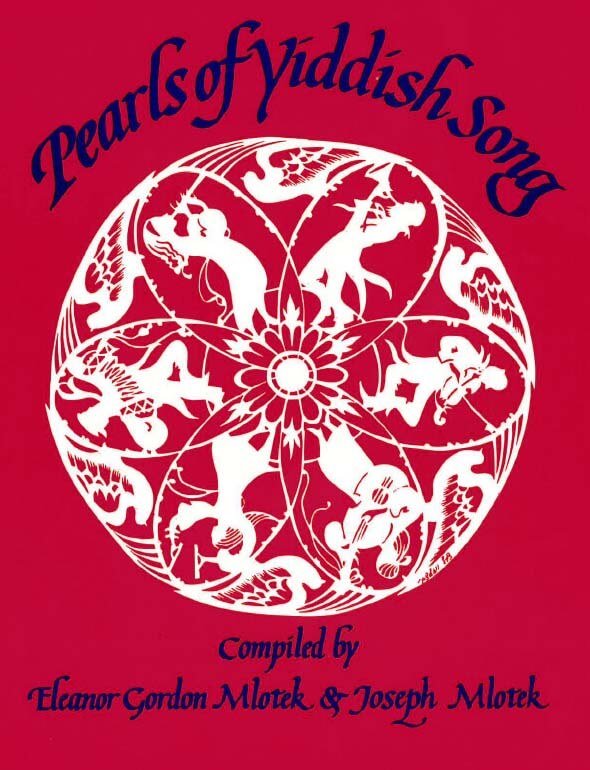Words by the Yiddish poet Mani Leib, pen name of Mani Leib Brahinsky (1883-1953); music by David Beigelman (1887-1944). Transcribed by compilers from a recording by a singer-actor Menashe Oppenheim.

Oh Darling Mother, Mother my Dear,
don’t drive the young tailor out of the house.
The young tailor, handsome as gold,
The young tailor is the one I love.
Oh, daughter, daughter! Woe is me!
Are you a match for a tailor?
You father will search the world and bring you
a fine bridegroom with status and money.
I don’t need status, I don’t need money,
I don’t want to squander my young life.
The young tailor is handsome as gold
The young tailor is the one I love.
The girl didn’t eat and didn’t sleep at night.
The tailor wandered around by the window, daydreaming,
Mother and Father considered the matter
and drew up the papers of engagement on a Saturday night.
The wedding was on Shabes-nokhmo.
Such a wedding had never been seen.
The couple shone like the sun,
friends and relations danced.
They ate and drank of the finest things,
until wine dripped from their beards,
and the fiddle and bass squealing and wailing*
could be heard in the farthest street in town.
Shabes-nokhmo. The “Sabbath of Consolation”, following the fast day on Tisha B’Av.
*Last two lines reversed to make more natural sense in English.
— Oy, mamenyu tayere, mamenyu lib,
Dem yunglinkn shnayderl trayb nit fun shtib.
Der yunginker shnayderl, sheyn iz vi gold,
Dem yunginkn shnayderl hob ikh dokh holt.
— Oy, tokhterl. Tokhterl, vey mayne yor!
Tsi den mitn shnayderl bistu a por?
Der tate vet brengen far dir fun der
velt
A tayern khosn mit yikhes un gelt.
— Ikh darf nit zayn yikhes, ikh darf nit
zayn gelt,
Ikh vil nit farshpiln mayn yunginke velt.
Der yunginker shnayderl, sheyn iz vi gold,
Dem yunginkn shnayderl hob ikh dokh holt.
Dos meydele est nit un shloft nit
bay nakht
Dos shnayderl blondzhet baym genster
fartrakht.
Un tatenyu, mamenyu hobn batrakht
Un tnoyim geshribn a shabes-tsu-nakht.
Un shabes nakhmu is di khupe geven,
Men hot aza khasene nokh nit gezen.
Azoy vi di zun hot dos porl geshaynt
Es hobn getantst mekhutonim un fraynd.
Gegesn, getrunken fun tayerstn sort,
Dos vayn hot gerunen ariber der bord.
Un s’hobn biz iber der zibeter gas
Di fidlen geveynt un geripet der bas.
— אױ, מאַמעניו טײַערע, מאַמעניו ליב,
דעם יונגינקן שנײַדערל טרײַב ניט פֿון שטיב.
דער יונגינקער שנײַדערל, שײן איז װי גאָלד,
דעם יונגינקן שנײַדערל האָב איך דאָך האָלט.
— אױ, טאָכטערל, טאָכטערל, װײ מײַנע יאָר!
צי דען מיטן שנײַדערל ביסטו אַ פּאָרל?
דער טאַטע װעט ברענגען פֿאַר דיר פֿון דער װעלט
אַ טײַערן חתן מיט ייִחוס און געלט.
— איך דאַרף ניט זײַן ייִחוס, איך דאַרף ניט זײַן געלט,
איך װיל ניט פֿאַרשפּילן מײַן יונגינקע װעלט.
דער יונגינקער שנײַדערל, שײן איז װי גאָלד,
דעם יונגינקן שנײַדערל האָב איך דאָך האָלט.
דאָס מײדעלע עסט ניט און שלאָפֿט ניט בײַ נאַכט,
דאָס שנײַדערל בלאָנדזשעט בײַם פֿענצטער פֿאַרטראַכט.
און טאַטעניו, מאַמעניו האָבן באַטראַכט
און תּנאים געשריבן אַ שבת־צו־נאַכט.
און שבת־נחמו איז די חופּה געװען,
מען האָט אַזאַ חתונה נאָך ניט געזען.
אַזױ װי די זון האָט דאָס פּאָרל געשײַנט,
עס האָבן געטאַנצט מחותּנים און פֿרײַנד.
געגעסן, געטרונקען פֿון טײַערסטן סאָרט,
דאָס װײַן האָט גערונען אַריבער דער באָרד,
און ס’האָבן ביז איבער דער זיבעטער גאַס
די פֿידלען געװײנט און געריפּעט דער באַס.
Song Title: Der Yunginker Shnayderl

First published in 1988 as Pearls of Yiddish Song: Favorite Folk, Art and Theatre Songs, this anthology contains 115 songs. Some material had never been published, while others, included in rare song collections or sheet music, were largely inaccessible. The songs presented reflect Jewish life in Eastern Europe and the United States and depict childhood, love, family celebrations, poverty, work and struggle. There are also songs from the Hasidic and Maskilic movements, songs of Zion and of America, as well as songs from the Yiddish theater.
The title of this anthology derives from the weekly two-page feature column “Pearls of Yiddish Poetry,” which the compilers Yosl and Chana Mlotek initiated in 1970 in the Yiddish newspaper Der Forvertz (the Yiddish Daily Forward). Hundreds of readers from around the world — including authors, composers, singers, actors — became co-participants in this collective folk project and recalled melodies, lines, fragments, stanzas and their variants of songs, poems, and plays which they had heard in their youth. At first, readers sent in only written material. Later, they also taped songs on cassettes, many of whose melodies had, until then, never been recorded. They also identified and supplied missing information regarding lyricists, poets, and composers and described the circumstances surrounding the songs’ origins, their dissemination, diffusion and impact.